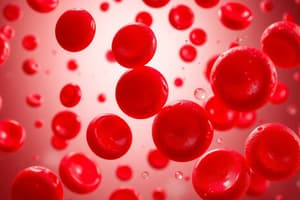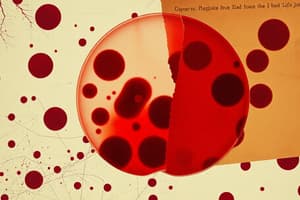Podcast
Questions and Answers
Which of the following is NOT a primary function of white blood cells?
Which of the following is NOT a primary function of white blood cells?
- Clean up cellular debris
- Transport oxygen from the lungs to the cells of the body (correct)
- Destroy abnormal cells
- Destroy invading microorganisms
What is the primary function of platelets?
What is the primary function of platelets?
- To transport oxygen to the tissues
- To fight off infections
- To provide structural support for blood vessels
- To stop bleeding from a damaged vessel (correct)
Which type of white blood cell is most abundant in the blood?
Which type of white blood cell is most abundant in the blood?
- Monocytes
- Neutrophils (correct)
- Eosinophils
- Lymphocytes
What is the role of hemoglobin in red blood cells?
What is the role of hemoglobin in red blood cells?
What is the approximate lifespan of a red blood cell?
What is the approximate lifespan of a red blood cell?
Which of the following conditions is characterized by an abnormally high number of red blood cells in the circulation?
Which of the following conditions is characterized by an abnormally high number of red blood cells in the circulation?
Which type of white blood cell plays a crucial role in allergic reactions?
Which type of white blood cell plays a crucial role in allergic reactions?
Which type of white blood cell is responsible for producing antibodies?
Which type of white blood cell is responsible for producing antibodies?
What is the primary function of monocytes?
What is the primary function of monocytes?
What is the term used to describe the process of stopping bleeding from a damaged vessel?
What is the term used to describe the process of stopping bleeding from a damaged vessel?
What percentage of blood is composed of plasma?
What percentage of blood is composed of plasma?
Which component of blood is primarily responsible for the regulation of pH and electrolyte balance?
Which component of blood is primarily responsible for the regulation of pH and electrolyte balance?
What is the primary function of globulins in blood?
What is the primary function of globulins in blood?
Which is NOT a function of blood?
Which is NOT a function of blood?
What remains after the blood has clotted?
What remains after the blood has clotted?
Which blood cell type is primarily involved in defending the body against infection?
Which blood cell type is primarily involved in defending the body against infection?
What is the main role of platelets in the blood?
What is the main role of platelets in the blood?
How does blood contribute to homeostasis?
How does blood contribute to homeostasis?
What immediate effect does vascular spasm have after blood vessel damage?
What immediate effect does vascular spasm have after blood vessel damage?
What role does ADP play in the formation of a platelet plug?
What role does ADP play in the formation of a platelet plug?
Which of the following describes the transformation occurring during blood coagulation?
Which of the following describes the transformation occurring during blood coagulation?
What is the primary function of fibrin in the clotting process?
What is the primary function of fibrin in the clotting process?
Which enzyme is responsible for dissolving a clot after it has formed?
Which enzyme is responsible for dissolving a clot after it has formed?
What is a potential consequence of inappropriate clot formation?
What is a potential consequence of inappropriate clot formation?
What condition can result from a deficiency of platelets?
What condition can result from a deficiency of platelets?
What initiates the activation of plasminogen during the clotting process?
What initiates the activation of plasminogen during the clotting process?
Flashcards
Blood Composition
Blood Composition
Blood consists of 55% plasma and 45% formed elements, including red cells, white cells, and platelets.
Plasma
Plasma
Plasma is the yellow liquid part of blood, primarily composed of 91.5% water and contains proteins and solutes.
Functions of Plasma
Functions of Plasma
Plasma functions in transport, osmotic distribution, and buffering pH changes.
Serum
Serum
Signup and view all the flashcards
Transport Function of Blood
Transport Function of Blood
Signup and view all the flashcards
Protection from Blood Loss
Protection from Blood Loss
Signup and view all the flashcards
Protection against Infection
Protection against Infection
Signup and view all the flashcards
Regulation of Homeostasis
Regulation of Homeostasis
Signup and view all the flashcards
Vascular Spasm
Vascular Spasm
Signup and view all the flashcards
Platelet Plug Formation
Platelet Plug Formation
Signup and view all the flashcards
ADP in Hemostasis
ADP in Hemostasis
Signup and view all the flashcards
Thromboxane A2
Thromboxane A2
Signup and view all the flashcards
Clotting Cascade
Clotting Cascade
Signup and view all the flashcards
Fibrin
Fibrin
Signup and view all the flashcards
Hemophilia
Hemophilia
Signup and view all the flashcards
Red Blood Cells (RBCs)
Red Blood Cells (RBCs)
Signup and view all the flashcards
Hemoglobin
Hemoglobin
Signup and view all the flashcards
Life Span of RBCs
Life Span of RBCs
Signup and view all the flashcards
Anemia
Anemia
Signup and view all the flashcards
Polycythemia
Polycythemia
Signup and view all the flashcards
White Blood Cells (WBCs)
White Blood Cells (WBCs)
Signup and view all the flashcards
Neutrophils
Neutrophils
Signup and view all the flashcards
Eosinophils
Eosinophils
Signup and view all the flashcards
Platelets
Platelets
Signup and view all the flashcards
Lymphocytes
Lymphocytes
Signup and view all the flashcards
Study Notes
Hematological System Overview
- Blood is composed of 55% plasma and 45% formed elements (red cells, white cells, and platelets).
- Total blood volume is 8% of body weight.
- Blood is drawn and separated into components through centrifugation.
- Plasma is the clear yellow liquid portion of blood, primarily water (91.5%).
- Plasma proteins include albumin, globulins, fibrinogen, and other proteins.
- Plasma proteins primarily function as clotting agents and antibodies.
- Water in plasma acts as a transport medium.
- Electrolytes in plasma maintain osmotic balance, buffer pH changes, and support nerve and muscle function.
- Plasma also transports nutrients, wastes, gases, and hormones.
Blood Components
- Plasma (55%) is primarily water (90%), plasma proteins (7%), and other substances (including electrolytes, nutrients, and hormones).
- Blood cells (45%) include red blood cells (RBCs, 99%), and white blood cells (WBCs) and platelets (<1%).
Functions of Plasma
- Transportation of dissolved gases, nutrients, and hormones to tissues and cells.
- Oxygen transport from the lungs and carbon dioxide removal.
- Nutrient delivery from the digestive tract.
- Hormone delivery to target organs.
- Waste product transport to the kidneys, lungs, and other organs.
Functions of Blood
- Prevents excessive fluid loss from damaged blood vessels through platelets and clotting proteins (hemostasis).
- Protecting against pathogens and toxins through white blood cells.
- Regulates body pH and electrolyte composition through buffers.
- Blood regulates body temperature through the dilation or contraction of blood vessels.
Blood Cells
- Blood cells are produced from hematopoietic stem cells.
- Three main types: red cells (erythrocytes), white cells (leukocytes), and platelets (thrombocytes).
Red Blood Cells (Erythrocytes)
- Disc-shaped with a large surface area.
- Can change shape.
- Lack nuclei and organelles.
- Contain hemoglobin for oxygen transport from lungs to body cells and carbon dioxide removal.
- Short lifespan (~120 days).
- Ruptured RBCs are destroyed in spleen, and phagocytic WBCs clear the debris.
- RBC production described through a diagram
Mechanism of Hemoglobin Transport
- Hemoglobin consists of four heme molecules, each binding to one oxygen molecule.
White Blood Cells (Leukocytes)
- Body's defense system.
- Destroy invading microorganisms and abnormal cells (e.g., cancer).
- Clean up cellular debris (phagocytosis).
- Types and their functions: neutrophils, eosinophils, basophils, monocytes, and lymphocytes (B and T lymphocytes).
Platelets (Thrombocytes)
- Cell fragments from megakaryocytes.
- Release important chemical mediators for blood clotting.
- Involved in the hemostasis process which has three stages: Vascular spasm, platelet plug formation and blood coagulation (clotting).
Hemostasis
- Three-step process of stopping bleeding: vascular spasm, platelet plug formation, and blood coagulation.
- Clotting cascade transforms blood from liquid to solid with multiple steps involving fibrinogen to fibrin.
Clot Dissolution
- Plasmin enzyme dissolves blood clots.
- Plasminogen is the inactive precursor activated by factor XII (Hageman Factor), occurring simultaneously with clot formation.
Clotting Disorders
- Thrombus (excessive clot formation) and embolus (free-floating clot).
- Hemophilia, lack of clotting factors, leading to hemorrhage.
Types of Anemia and Polycythemia
- Anemia (low hemoglobin): Nutritional, pernicious, aplastic, renal, hemorrhagic, hemolytic.
- Polycythemia (abnormally high hematocrit): Primary and secondary.
Additional Information
- Questions about blood composition, red blood cell function, hemoglobin function, and roles of neutrophils and lymphocytes were included in the presentation.
Studying That Suits You
Use AI to generate personalized quizzes and flashcards to suit your learning preferences.




